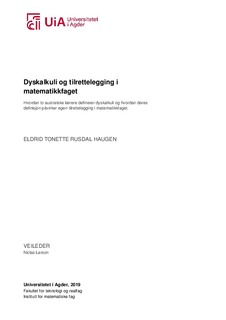| dc.contributor.author | Haugen, Eldrid Tonette Rusdal | |
| dc.date.accessioned | 2019-10-22T10:21:46Z | |
| dc.date.available | 2019-10-22T10:21:46Z | |
| dc.date.issued | 2019 | |
| dc.identifier.uri | http://hdl.handle.net/11250/2623673 | |
| dc.description | Masteroppgave matematikkdidaktikk MA502 – Universitetet i Agder 2019 | nb_NO |
| dc.description.abstract | This paper is written as a master thesis in MA-502 at the University of Agder. The primary focus ofthis thesis is to investigate the effect the individual understanding of the dyscalculia diagnosis by two Australian teachers, has on their teaching methods. Their view of dyscalculia, their experiences with students with learning difficulties in mathematics, their teaching strategies and how they view and handle student’smathematics anxiety are then discussed in relation to relevant theory on dyscalculia and its components. Low response rates among potential interviewees and lacking knowledge of dyscalculia with the interviewees lead the focus of the paper to shift towards learning difficulties within mathematics, rather than a strict focus on the specific dyscalculia diagnosis.Two teachers working in two different regions in Australia were interviewed on their experience and knowledge of dyscalculia. For the purpose of this paper, they are John and Mary. John has 25 years of experience as a teacher, and Mary 15. John first learned of dyscalculia as a diagnosis 5 years ago andrelates much of his assessment of dyscalculia to learning difficulties found in children that are diagnosed with dyslexia. Mary is in her first year as a math teacher, and has previously taught science, physics and chemistry. In these subjects calculations have made up a significant amount of the work of the students. She only learned about the term dyscalculia in the recruitment email send out by the author of this paper.John reports using visualizationaids when working with students that struggle with mathematics, for instanceplasticine to physically mimic mathematical symbols. Mary makes use of playing cards with calculations written on them. This paper discusses different definitions of dyscalculia. John and Mary’s differentiation in mathematics corresponds with their definitions of dyscalculia. The components mentioned in their dyscalculia definition is mirroredin what they describe about their teaching. The link between the individual teacher’s definition and choice of differentiation method is strong, but the resemblance between them is not. | nb_NO |
| dc.language.iso | nob | nb_NO |
| dc.publisher | Universitetet i Agder ; University of Agder | nb_NO |
| dc.rights | Attribution-NonCommercial-NoDerivatives 4.0 Internasjonal | * |
| dc.rights.uri | http://creativecommons.org/licenses/by-nc-nd/4.0/deed.no | * |
| dc.subject | MA502 | nb_NO |
| dc.title | Dyskalkuli og tilrettelegging i matematikkfaget : Hvordan to australske lærere definerer dyskalkuli og hvordan deres definisjon påvirker egen tilrettelegging i matematikkfaget | nb_NO |
| dc.type | Master thesis | nb_NO |
| dc.subject.nsi | VDP::Samfunnsvitenskap: 200::Pedagogiske fag: 280::Fagdidaktikk: 283 | nb_NO |
| dc.source.pagenumber | 82 s. | nb_NO |

